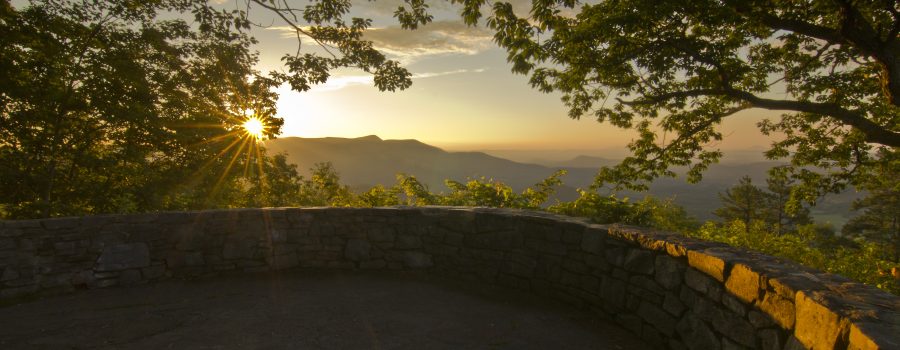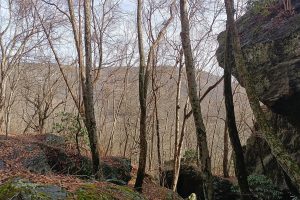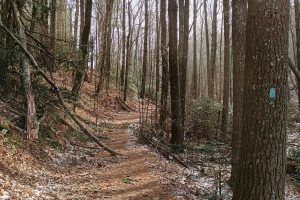To visit three national parks in one trip set your sites on the mountains of Virginia, North Carolina and Tennessee. In about a 500 mile stretch, you’ll experience the wonders of the Great Smoky Mountains, the Blue Ridge Parkway and Shenandoah National Park.
Great Smoky Mountains
Stradling North Carolina and Tennessee, the Great Smoky Mountains National Park has sixteen peaks over six thousand feet along with elevations below one thousand feet. The variety in elevation is only matched by the diversity of flora and fauna found throughout its more than 500,000 acres. Visitors can drive, bicycle, hike or ride horseback in the park. No matter the mode of transportation, wildlife, wild flowers, waterfalls, historic sights and stunning views abound.
Two of the most notable stops are Clingmans Dome and Cades Cove. Clingmans Dome is the highest point in the park. There is a paved and elevated trail to the top, but check on the restrictions. Pets are not allowed, and it is too steep for bikes and wheelchairs. Cades Cove is a four thousand-acre valley with a loop road, numerous trails, historic settlements and wildlife viewing.
Fishing is another popular activity in the park. With 730 miles of fish-bearing streams and another 1,300 miles of tributaries, a line thrown in is bound to snag something. Bass and trout are just two of the fifty-three species of fish in the park’s waters.
In addition, there is no entrance fee. Camping and lodging options in and around the park are plentiful. The majority of the park’s 384 miles of roads are paved, and the gravel roads are maintained. Visitors travelling in RVs and towing campers or trailers need to pay attention to road restrictions.
The Blue Ridge Parkway
From the Great Smoky Mountains, catch the Blue Ridge Parkway in Cherokee, NC and head north. The 469-mile linear park is known as America’s favorite drive. It will take you over the heights of North Carolina’s Blue Ridge Mountains and down into the Blue Ridge Plateau in Virginia. Driving along the rolling hills, visitors ascend into the mountainous regions of Virginia. At Rockfish Gap, near Waynesboro, VA, the Parkway merges into Shenandoah National Park and its Skyline Drive.
Along the Blue Ridge Parkway, there are numerous places to stop, such as Linville Falls, Chimney Rock, Natural Bridge, Blowing Rock and Mount Mitchell. Don’t forget to include some of the mountain towns along the parkway. Each one has its own selection of history, music, eateries and sights. Make sure you stop at the overlooks to soak in the views and learn historical and ecological tidbits at the educational placards.
The Blue Ridge Parkway does not have an entrance fee. The road is two-lane and paved. The speed limit is mostly 45 mph, but it does drop to 25 to 35 mph in places. For those traveling in RVs or towing, there are tunnels and sharp turns in the more mountainous sections. In the mid-section of the Parkway, where Fancy Gap Cabins and Campground is located, there are no such barriers.
Where to Stay on the Blue Ridge Parkway
Our campground and motel is roughly midway on the Parkway at approximately milepost 203. Guests can stay with us in a camping cabin or motel room as well as a tent site are RV space are selection. From our location, guests head to sites such as Mabry Mill, the Blue Ridge Music Center, the New River, the Devil’s Den Nature Preserve, Cumberland Gap and Rocky Gap. Another reason guests like to stay with us is the annual festivals that are held in neighboring communities of Galax, Hillsville and Mt. Airy, NC.
Other lodging options include the National Park Service campground at Rocky Knob Recreation Area. Use the Blue Ridge Parkway Association’s interactive map or app to find other lodging and campgrounds off the parkway in neighboring towns.
Shenandoah National Park
Skyline Drive is the centerpiece of Shenandoah National Park. The 105-mile drive cuts through the 200,000 acre park connecting Rockfish Gap with Front Royal, VA. Visitors can drive, bike or walk along Skyline Drive. The entire way, marvel at views of the Blue Ridge Mountains and Shenandoah Valley as well as wildlife and wildflowers.
If you’re up for a hike, there are over 500 miles of trails that included 101 miles of the Appalachian Trail. Camping and lodging options in and around the park are numerous. Similar to the Great Smolky Mountains and the Rocky Knob on the Blue Ridge Parkway, there are back country campsites that require a permit. Along with hiking, the park also provides opportunities for fishing, rock climbing and birdwatching.
There are fees to enter Shenandoah National Park and a separate day use pass to hike Old Rag Mountain. Skyline drive is paved with a maximum speed limit of 35. There is a tunnel with a maximum clearance of 12 feet 8 inches.
Tips for Your Trip
Make sure to have physical maps. GPS is not always reliable, and cell service is spotty in all three parks. Inside the parks, you won’t find gas stations or charging stations for electric vehicles. Make sure you know where to fill up or charge up. The same goes with food. Check out the location of restaurants and convenience stores before you leave.
Road conditions, tunnel heights and peak visitor times are three other points to research. Remember, many people head to these three national parks in the fall. If that’s your plan, book early. Fall in the mountains is as busy if not busier than the summer. Make sure to bring a variety of cloths. Even in the hottest times of year, temperatures in the evening and morning can turn chilly.
Whether you’re an adventurer or a casual sight-seer, tackling three national parks and three states in one trip will make for a vacation full of memories. Plus, you may find that special destination to return to year after year.
Image credit @imagesbyleianegibson





Leave a Reply
Your email is safe with us.